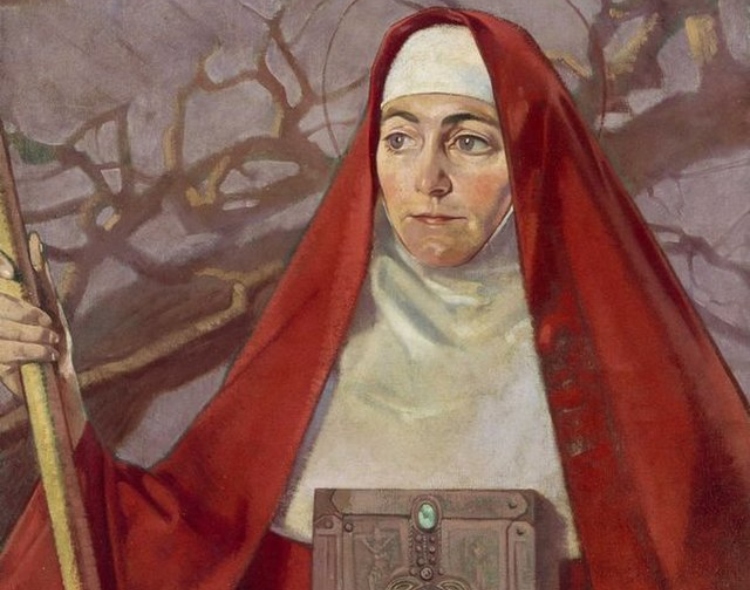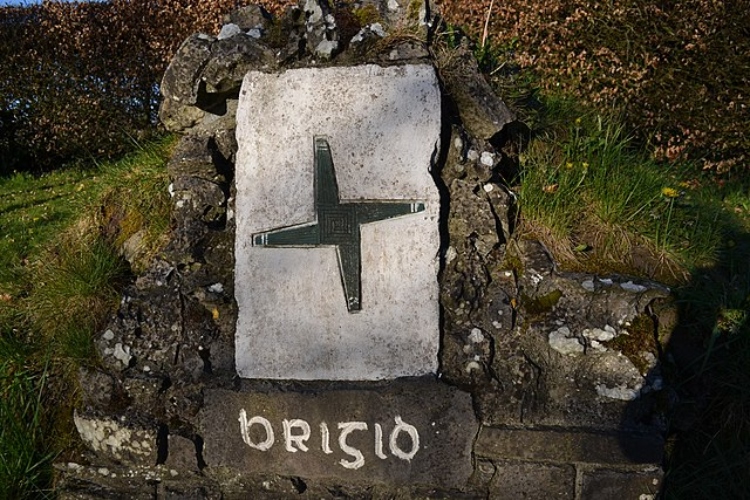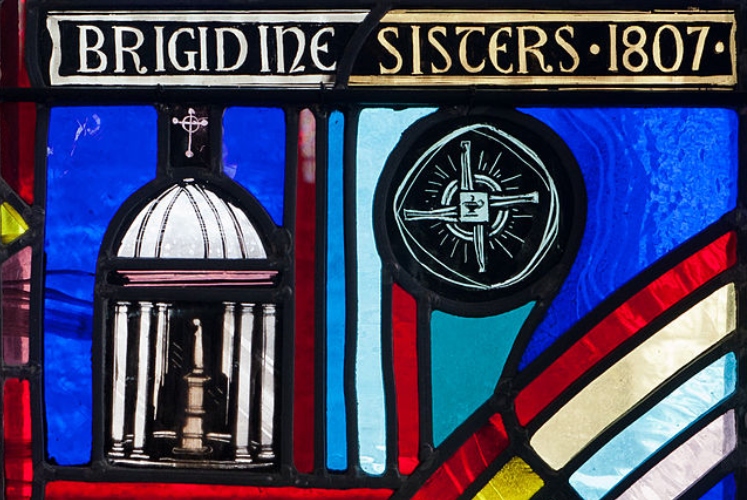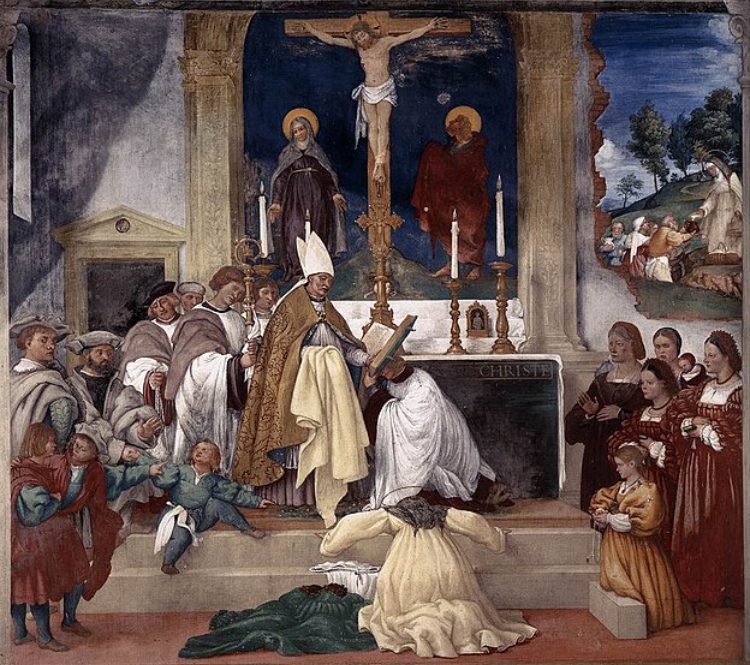St. Brigid of Ireland & Her Iconic Cross
Mar 17, 2023 by Cheryl Hadley
St. Brigid is one of the three beloved Patrons of Ireland. Her Cross is an ancient symbol of history, legend, and faith that has spanned generations, and become a part of the heritage of Irish Catholics. Here is the history of this remarkable saint and her iconic Cross.

Her Childhood
Brigid was the daughter of a powerful pagan Chieftain named Dubthach and a Christian woman named Brocca, who was baptized by St. Patrick. Brigid's mother was born a free woman in Portugal, but kidnapped by Irish pirates, like St. Patrick, and sold into slavery, so Brigid was born a slave.
Her father named her after one of the most powerful goddesses of his pagan religion, Brigid, the goddess of fire. As she grew, she worked on her father's farm in menial jobs, cooking, cleaning, washing, and feeding the animals.
[[855]]
St. Patrick's teachings inspired her, and she became a Christian like her mother. Stories of Brigid's childhood recount her purity and her generosity to others. In many of these, she gave away her food stores and possessions, then found them miraculously replenished.
Brigid could not resist giving aid to those in need, and her father eventually tired of her charitable nature, unable to understand it. He took her to the Christian King of Leinster, intending to sell her. As they spoke, Brigid gave her father's jeweled sword to a begging leper so he could barter it to feed his family.
When the King saw this act of charity, he was taken aback. He explained her purity of heart to her pagan father. "Her merit before God is greater than ours," he told Dubthach, and he convinced him to free Brigid to do God's work.
[[31568, 48659]]
Dubthach attempted to arrange Brigid's marriage to a bard, but she refused, desiring only to devote herself to the Lord. She made a vow of chastity, praying that her beauty would be taken away so no man would desire her for marriage.
Legend has it that her prayer was granted, and eventually her father relented. She was able to enter the Church, and after she made her final vows in religious life, her incredible beauty was restored.
Life in the Church
As word of her good works and love for God spread, many young girls sought to follow Brigid into the Church and religious life.
She wanted to build a monastery in County Kildare, and found a suitable location near a forest (for gathering wood) and close to a river (for fresh water). She appealed to the King to give her the land, but he refused. On the land was the pagan shrine to the Celtic goddess Brigid, for whom she had been named.
The saint was not deterred by the King's refusal. Her sisters and she prayed that the King's heart would soften. She returned, and asked him if he would give her as much land as her cloak would cover. Seeing the small cloak on the back of the young woman, he laughed and readily agreed.
She asked four of her sisters to take the cloak by its corners and begin walking. As they did, the cloak grew miraculously, spreading across many acres. The sisters continued to walk, to the amazement of the King and his household. Brigid knew the Lord would provide.
[[2256,31584]]
Building the Kingdom
She chose the spot above the pagan shrine to the Celtic goddess Brigid, and construction of her monastery began there. There was ample land for dual monasteries to house both men and women. The King became her patron, providing for their needs by assisting with funds, food, and other gifts. He later converted to Christianity.
In addition to the two monasteries, Brigid also founded a school of art, metalwork, and illumination of manuscripts, at which the famous Book of Kildare was illuminated. It is said to have been the only rival to the Book of Kells before it was lost three centuries ago.
[[34084,7633]]
The Trias Thaumaturga, the history of the three Patron Saints of Ireland, St. Brigid, St. Patrick, and St. Columba, reveals that St. Brigid and St. Patrick were close friends who worked together to convert the pagans of Ireland and serve the poor.
The book states, "Between St. Patrick and Brigid, the pillars of the Irish people, there was so great a friendship of charity that they had but one heart and one mind. Through him and through her Christ performed many great works."

Her Beloved Cross
St. Brigid designed her cross, known now as the Cross of St. Brigid, under fascinating circumstances. An old pagan chieftain was on his deathbed, and the saint was called to his bedside by his servants to calm him.
As she sat beside the old man, she spoke gently to him and began picking up rushes from his floor. These were often used to warm the floor, and commonly found in many homes. As she spoke, she began weaving the rushes into the shape of a cross.
The dying man took notice, and asked St. Brigid what it was. While continuing to weave, she explained the meaning of the Cross of Christ and revealed the love behind the Paschal mystery. This captivated the pagan and seized his heart. He was so overcome by grace that he converted, and was baptized just before he died.
[[2331,2274]]
Brigid's beloved symbol sprang up during a time when Catholicism and paganism both existed in Ireland, so it was compared by some pagans to their sun wheel, which was a symbol of fertility and blessing. It became well known among both Christians and pagans.
A Sacramental for Home
For Irish Catholics, displaying a St. Brigid's Cross is a way of asking God to protect and bless a home. After St. Brigid made it by hand, it became a symbol of peace, blessing, and goodwill in Ireland.
In addition to their homes, families also placed it in barns, praying for God's protection over the animals and His blessings upon the supplies of grain, milk, and other staples important for the sustenance of the Irish people.
Today, many Irish Catholics display the St. Brigid's Cross above their doorways or beside their front doors. They are often made and blessed to be given out at Mass on her feast day in Ireland.
[[13584]]
When hanging the cross at home, Catholics bless it with holy water and pray:
May Brigid bless the house wherein we dwell.
Bless every fireside, every wall and door.
Bless every heart that beats beneath its roof.
Bless every hand that toils to bring its joy.
Bless every foot that walks portals through.
May Brigid bless the house that shelters us.
Amen.

Mother Saint
St. Brigid is known as the "Mother Saint of Ireland," and the "Mary of the Gael." She shared the love of God through her hospitality and care of the poor and the sick. Her labors of love in founding her monasteries brought the graces of increased faith and prayer to her people. With St. Patrick, this girl born into slavery helped convert pagan Ireland.
Using her beloved cross to teach about Christ's life, death, and Resurrection, Brigid brought His healing to the wounded, His comfort to the weary, and His hope to the downcast. She inspires us to strengthen what is weak in us, to give of ourselves completely, and to trust in God's Providence as we bring Christ to others and share His love today.
[[37897,45671]]






